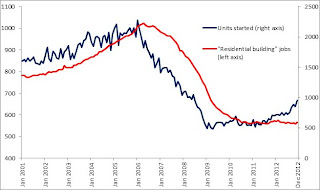by Calculated Risk on 1/31/2013 02:13:00 PM
Thursday, January 31, 2013
Kolko: Here are the “Missing” Construction Jobs
CR Note: This is from Trulia chief economist Jed Kolko:
Construction jobs are a big part of how housing recovery lifts the broader economy. But the construction rebound, so far, appears to be jobless. “Residential construction” jobs, as reported by BLS, were up just 1% in December 2012 from their lowest level since the housing bubble burst – even though new home starts in December 2012 were twice as high as their low point in 2009. Overlaying residential construction employment (monthly, in thousands, left axis) and construction starts (monthly, in thousands, right axis) data suggests a jobless housing recovery, with jobs struggling to turn around even as starts climbed sharply in 2012:
 Click on graph for larger image.
Click on graph for larger image.
Who is building all these new homes? If starts are now twice their lowest level, why aren’t residential building jobs also twice their lowest level, instead of up just 1%? The answer: this is the wrong way to look at construction jobs. It turns out that construction employment is approximately where it should be for the current level of construction activity. Here are three reasons why:
“Starts” aren’t the right measure of current construction activity. Units “under construction” is more relevant – especially now. The amount of construction activity this month depends not only on this month’s construction starts but also on construction starts in previous months. That’s because single-family construction takes 4-6 months between start and completion, and multi-unit-building construction takes 10-14 months, on average. Therefore, construction starts indicate what will happen to construction activity in the coming months – not necessarily where it is today. And, in this recovery, multi-unit buildings are an unusually high share of overall construction activity, so the typical new unit is under construction for longer, making starts an even-worse-than-usual proxy for current construction activity. Instead of starts, units “under construction” – also reported monthly by the Census – is the right measure of construction activity to compare with jobs. This changes the picture dramatically: while monthly starts in December 2012 were up 100% (that is, have doubled) since the bottom, monthly units under construction were up 32% from the bottom.
The “residential building” jobs category understates growth in residential construction jobs. The BLS “residential building” category covers general contractors and construction management firms but not subcontractors, which are covered under another category the BLS tracks, “residential specialty trade contractors.” Importantly, residential construction jobs have been shifting steadily from general contractors to specialty trade contractors throughout the boom, bust, and recovery, so the narrower “residential building construction” category understates recent growth in construction jobs. “Residential building” jobs in December 2012 were up just 1% from the bottom, while “residential specialty trade contractor” jobs were up 4%. The combined series is up 3% from the bottom. Of course, some construction workers might not be officially counted if they’re off the books, and others might work on both residential and non-residential projects and not fit neatly into one reporting category. Still, looking at both the “residential building” and “residential specialty trade contractors” gives a clearer picture than looking only at “residential building.”
Construction jobs do not move one-for-one with construction activity. Looking at the right measures over time – units under construction and the sum of the two jobs categories – jobs move up and down less than construction activity does. For every 10% increase (or decrease) in the number of units under construction, construction employment increases (or decreases) by a little more than 4%. One reason might be what economists call “labor hoarding” – firms hold onto more workers than they need in temporary downturns if the cost of firing and re-hiring is high relative to keeping them on. Therefore, firms might increase or reduce workers’ hours instead of hiring or firing. Another reason is other construction activities, like remodeling, might move differently with the business cycle than new construction and possibly even soften the ups and downs of demand for construction workers.
Overlaying these two series – “units under construction” (Census) and the sum of “residential building construction” and “residential specialty trade contractors” (BLS), we get:
 Using these measures, jobs track construction activity pretty closely, with a slight lag. Taking this lag into account, a simple time-series model suggests that construction employment is now just 2% lower than it should be for the current level of construction activity.
Using these measures, jobs track construction activity pretty closely, with a slight lag. Taking this lag into account, a simple time-series model suggests that construction employment is now just 2% lower than it should be for the current level of construction activity.
The picture might change tomorrow in the January jobs report. As part of tomorrow’s report, the BLS will release its annual benchmark revision of previously reported employment figures. The preliminary revision announced in September suggested that employment for construction overall (including non-residential) would be revised up 1.6% for the benchmark month (March 2012). If tomorrow’s official revision to residential employment is in that range, the jobless construction recovery might not be missing any jobs at all.
What does this mean for construction employment in 2013? Suppose starts rise another 20% in 2013 relative to 2012 – a bit slower than the 28% increase in 2012 relative to 2011. Recent trends suggest that the number of units under construction should be a hair over 20% higher in December 2013 than in December 2012. Even though units under construction didn’t grow as fast as starts in 2012, much of the effect of the increase in starts in 2012 will be on construction activity in 2013, not in 2012. As a result, construction jobs – residential building plus residential specialty trade contractors – could grow 8% in 2013. The sharp increase in construction starts in 2012 should mean more construction jobs in 2013.


